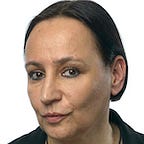Searching for German-Jews in New York
In 2011, the Leo-Baeck Institute in New York and the Baruch College Jewish Studies Center held a conference entitled “German-Speaking Jews in New York City: Their Immigration and Lasting Presence”.
Only a handful of German-Jewish émigrés, who had fled to the United States from Germany in the early 1930s, were present. I was sitting in the audience, missing the many German-Jews whom I’ve met in New York in the early 1990s, when I was managing editor of the legendary German-Jewish newspaper Aufbau (which was founded in 1934 and folded in 2004. Read my article about Aufbau’s history, in German). I remembered our devoted German-Jewish readers, so attached to their paper that they would call the office to ask for the time. I missed our German-Jewish freelance writers and photographers, who had so much inner strength, poise and intellect.
The almost empty auditorium at the Leo-Baeck Institute made me miss them even more.
It was ironic that of all the Jewish institutions in New York, it was the Leo-Baeck Institute that hosted a conference like this. Even though the Institute has dedicated itself to preserving German-Jewish culture, back when Aufbau struggled to survive, we approached its directors again and again to help us save the paper, at least as long as there was still one survivor, one German-Jew, alive. Our pleas, however, fell on deaf ears. To be fair, there were a few individuals on the Institute’s board who supported us as much as they could, but officially, the Leo-Baeck Institute never seemed to care too much about Aufbau’s demise.
Now, panelist after panelist remembered the Aufbau and its important role in the survivors’ lives. For them, however, and for the paper, these reminiscences and acknowledgements come too late.
I miss the resolute Werner Stein and the soft-spoken Jerry Brunell, chairman and publisher respectively of the Aufbau. I had fierce discussions with both of them about which direction the paper should take, but I always learned something new from their experiences; their stories will stay with me forever. (Werner Stern contacted me on June 16, 2011, after learning about this blog post, and I was glad to learn that he is well! I hope that Jerry Brunell is too.)
I miss our freelance writers, like our 80-year-old art critic Judith Helfer, who had the wrinkle-free face of a delicate Chinese porcelain doll and a soft voice to match her features. Judith came from a prominent family of Rabbis; she died in 2002.
I miss Frederick R. Lachman, a Jewish scholar, author, historian and executive editor of the Encyclopedia Judaica, who wrote Aufbau‘s column “Was das Judentum dazu sagt”, on how Judaism approached the issues of the day. Lachman — with his disarming wit, poignancy and very long-form writing style — once took me aside and shared with me his anguish that some people still thought that German-Jewry started with Hitler. “Child,” he urged me, “continue to fight this misjudgment.” I have and always will. Lachman died in 1998 at the age of 96.
I miss our photographer Erich Hartmann, who worked for MAGNUM and accompanied me to many assignments, most memorably to an interview with Wolf Ulrich von Hassell, the son of a German resistance fighter in Nazi Germany. You can read the article (in German) and view the photo Hartmann took here. Hartmann, who was as elegant and polite as an English gentleman and such a Mensch, passed away in 1999.
I miss Lisa Schwartz, who was the vice president and Grande Dame of Aufbau. As a former hat model, she was as eccentric and charming as you’d imagine, and I miss her dry humor and hearty laughter. She chain-smoked and flirted with everyone. She had survived the war in Switzerland as a child and still vacationed there every year. We lost contact. She passed away in March 2012 at the age of 90. May she rest in peace.
Years back, all of them would have been present at a conference like that, either participating in the panels, sitting on the podium, or in the audience.
But very few people sat there with me now, as if I needed a reminder that their numbers were dwindling and that their children and grandchildren, for the most part, didn’t care much about their German-Jewish roots.
But there are still a few witnesses, like retired history professor Henry L. Feingold and Max Lerner, who came to New York from Germany and Austria respectively in the late 1930s early 1940s. Both recounted their experiences after arriving in the New World:
Representing the second and third generation was author and poet Janet R. Kirchheimer (How to Spot One of Us), who shared her grandparents’ and parents’ experience after coming to New York.
In her poems (i.e. “This Is How My Opa Strauss Died“), she comes to terms with her own German-Jewish heritage and identity:
I don’t know how many survivors will sit in the audience, or on the podium, for future conferences. But I do know that I will miss those who won’t.
Copyright © Tekla Szymanski | All Rights Reserved
Originally published at Content + Design LLC.
